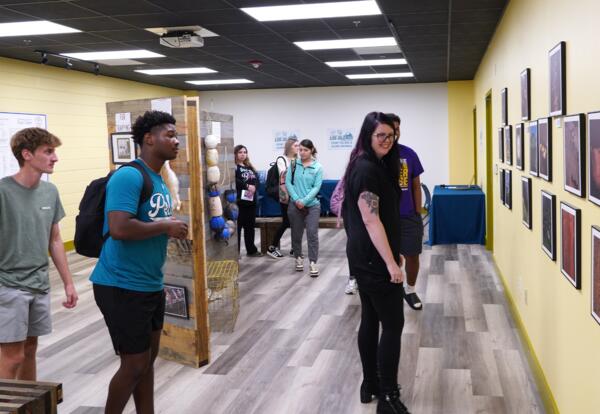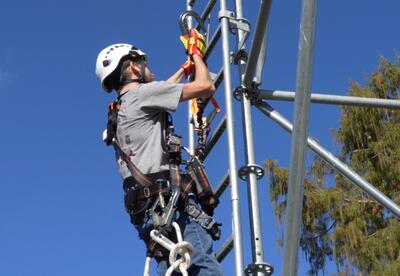
Nunez Community College opened its Los Isleños Historical Archive Aug. 27 with an open house for special invited guests. The archive is open and available to the public on the second floor of the Nunez Library. Pictured, Nunez instructor Taylor Amalfitano leads her class through the archive.
The legacy of the Isleño people in St. Bernard Parish is preserved in a unique historical archive at Nunez Community College.
An open house held Aug. 27 in the Nunez Library served as a soft opening for the Los Isleños Historical Archive. The collection, which has been used in the past by visiting scholars, is now open to the public, and will grow in the coming years with the addition of present-day interviews to the oral history collection, complete digitization and translation of the existing archive, and online access.
The collection is comprised of hundreds of artifacts, photos, video recordings and oral histories donated by Frank M. Fernandez Jr., former St. Bernard Parish Historian.
“This day has been a long time coming,” Dr. Tina Tinney, Nunez Chancellor, told guests at the open house.
During her remarks, Dr. Tinney shared that the archive was a passion project and one she was committed to bringing forward during her tenure. She also noted the good fortune in the collection being housed in a vault on the second floor of the Nunez Library since it was donated more than 25 years ago. Otherwise, it likely would have been lost during Hurricane Katrina.
“It means so much to me to see everyone come together to offer support for something that holds deep significance to our college and our community. Archives are both a mirror and a map—reflecting who we are and guiding us toward a deeper understanding of where we come from,” she said.
The archive is one of a kind according to Bill Hyland, current St. Bernard Parish Historian.
“No other parish has anything like this,” he said.
Hyland worked closely with Fernandez for years documenting Isleño history and culture. Beginning in the 1980s, Fernandez began making hundreds of video recordings of Isleño elders and community members. The interview topics from those tapes range from family genealogies to folklore to traditional Isleño cuisine, such as the Caldo, Gazpacho Andaluz and Torte De Almendras prepared for the open house by Nunez’s Culinary program.
Nunez Community College was a subrecipient of U.S. Treasury Grant RESTORE Act funds made possible through partnership with St. Bernard Parish’s Coastal Department. Coastal Director John Lane shared that “Coastal erosion not only reshapes our physical landscape—it is also tied to cultural erosion, which significantly impacts people. This archive is an investment in ensuring that land loss doesn’t wash away the rich cultural histories that tell the story of a changing community.”
Further examining the link between coastal preservation and cultural preservation, Dominique Siebert, Marine Extension Agent for Louisiana Sea Grant and LSU AgCenter, delivered a brief presentation on coastal land loss, which has affected the Isleño population in St. Bernard. She also highlighted several promising restoration projects that are building new land along the Gulf Coast.
.png)



